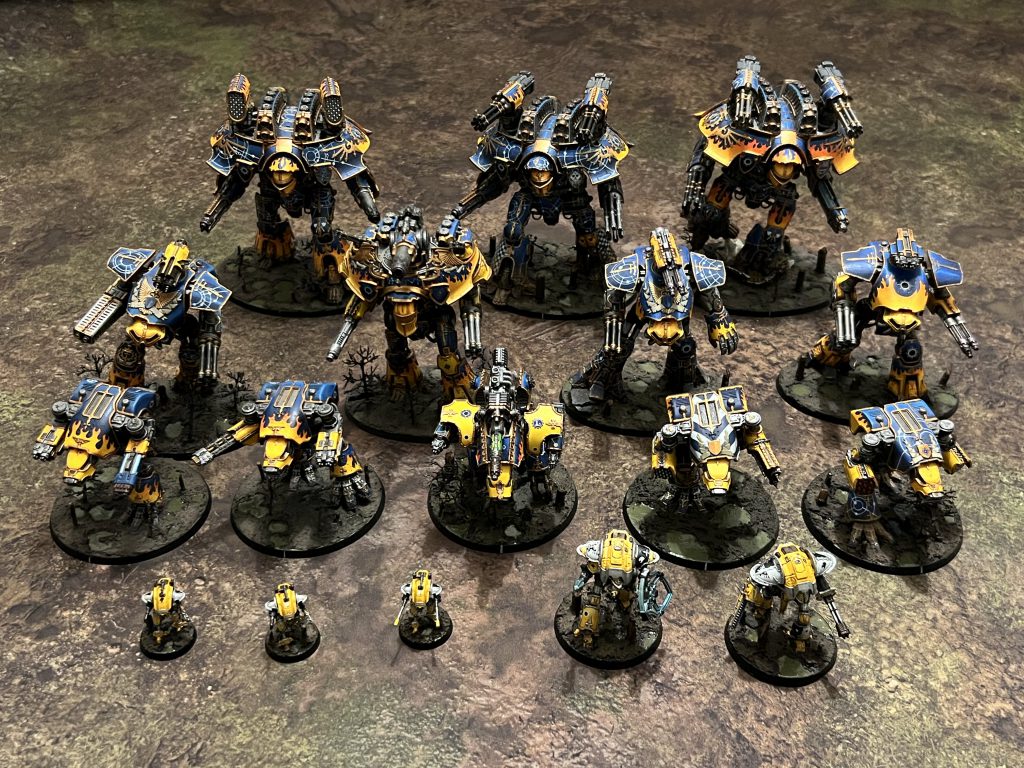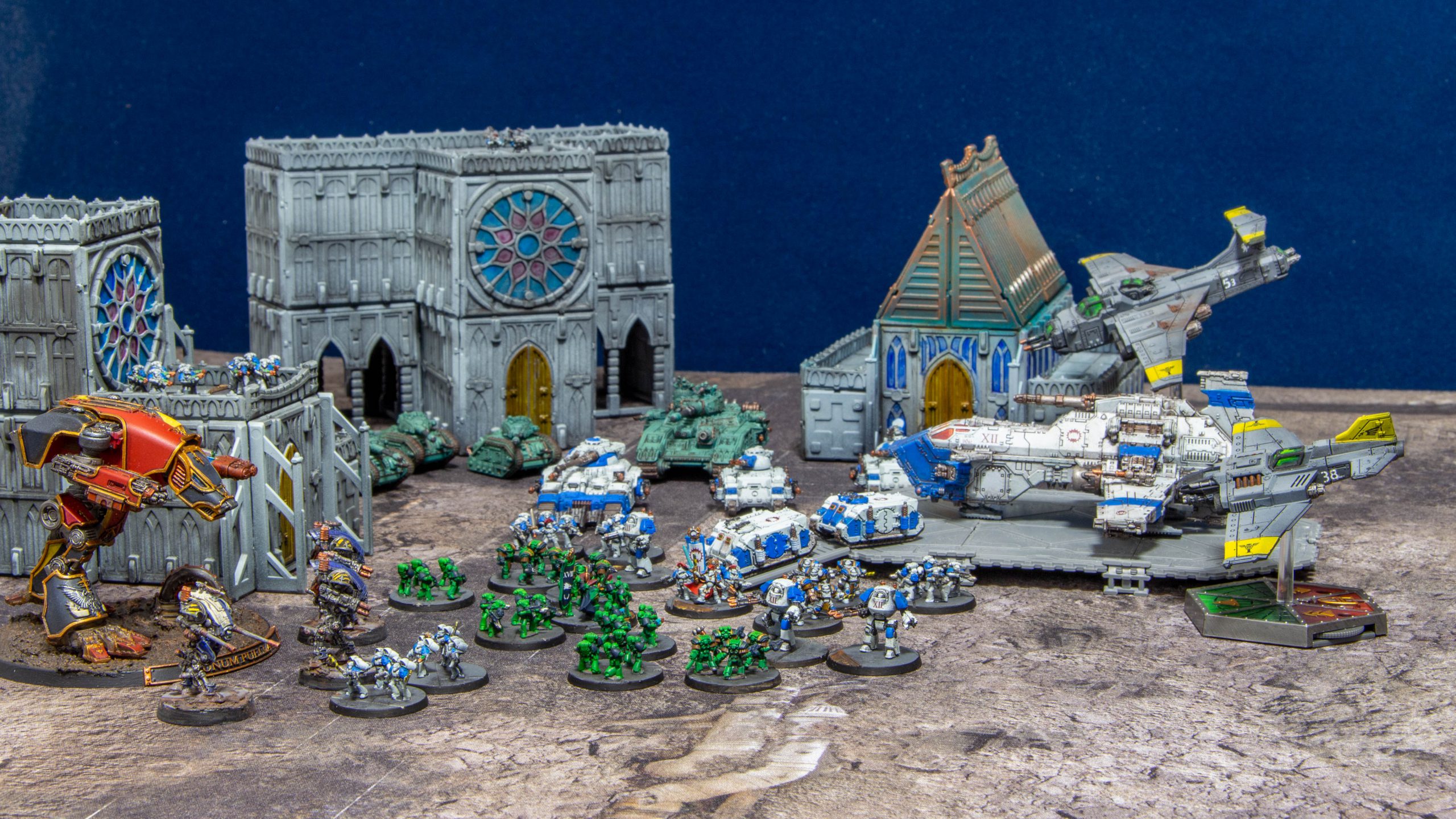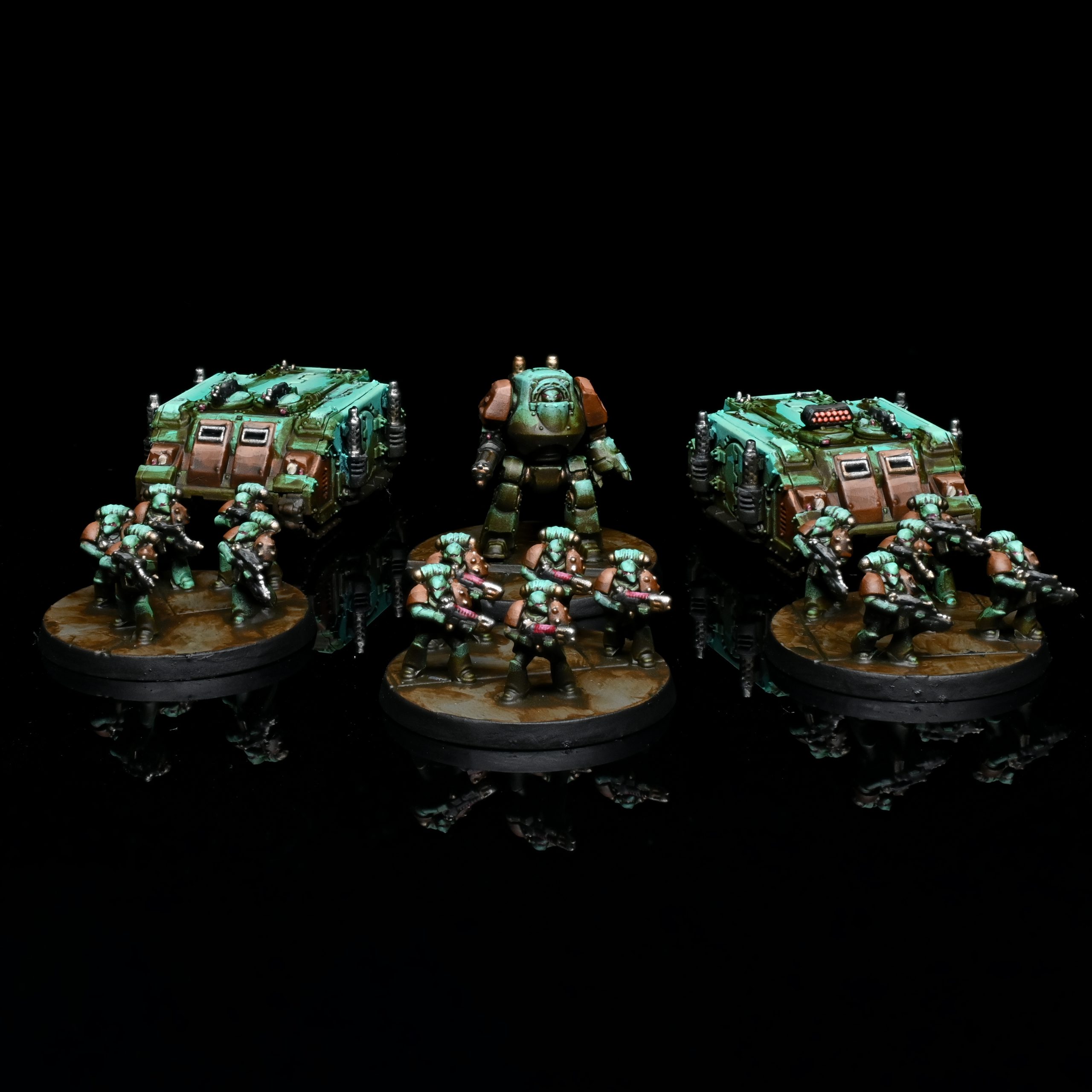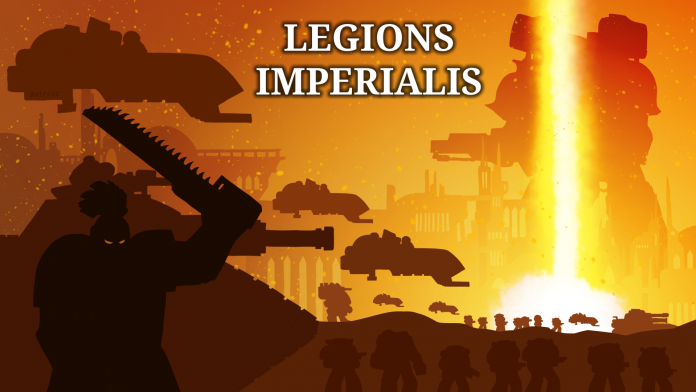The Great Slaughter provides a lot of new content for Legions Imperialis players, not unlike the old Black Books for Heresy. About the first half of the book is background with maps, timelines, force numbers and sections called things like “The Years of Blood and Death” or “A Sword Flung from the Heavens”. Great stuff.
This article is looking at the middle of the book. Here we find rules for campaigns in Legions Imperialis and Titandeath – a special game mode where you only use Knights and Titans – lots and lots of Knights and Titans.
Thanks as ever to Games Workshop for providing us with a copy of The Great Slaughter to review.
Titandeath

Adeptus Titanicus is possibly the best game Games Workshop makes. It’s got a near-perfect balance of tactical depth, mechanical crunch and uncontrolled mayhem. But if you don’t want to worry about terminals to carefully balance the reactor heat, weapon output and shields of a titan maniple this game mode lets you put a load of engines on the board and get blazing away with no mess and no fuss.
I have to admit, I was pretty suspicious of this game mode at first. I really like Titanicus and I don’t want them to drop it in favour of this vastly less detailed representation of titanic conflicts. That concern makes me a bit prejudiced against Titandeath if I’m honest, but I’ll try and judge the game on its own merits.
This is an attempt to make a proper game using the rules for Titans and Knights in Legions Imperialis. They provide some minor but sensible rules changes, like letting the firer allocate hits from shield-stripping weapons first and then fire your Engine Killer weapons once the target’s shields are down – but you pay more points for Engine Killer guns. There are three perfectly serviceable missions to play, which give you deployment maps and symmetrical objectives, and also some secondary objectives that aren’t too balanced but will add to the fun. And this is all totally fine.
You play with armies of 6000 points, selected only from Knights and Titans – naturally without the usual restriction of only spending 30% of your points on them. That, as I mentioned previously, is a lot of engines. To illustrate just how many I broke out pretty much all of my Adeptus Titanicus collection – or all that’s painted and based at least. This is a 6000 point Titandeath army of the Legio Astorum, ready to make some traitors seriously, but briefly, regret their life choices. (Condit: Rude.)

This is making me wish that my Warmaster and Psi-titan, both of which I’ve had in a WIP state since they were first released, were finished. Oh well!
Seeing all these engines together is a bit thought-provoking though. Honestly this is too many engines to field at once in Titanicus. It would take too long and I find the mechanics get a bit strained if there are too many models on the board. Engines just die in a round, so all the interesting stuff with repairs, voids, and ongoing critical damage goes out the window.
But it would be good to field all these titans together and Titandeath lets you do it. This is a game that lets you get all your models, or perhaps combine your collection with a few friends, and stage apocalyptic titanic clashes.
I think this does have legs as a club game, where several players being their collections in, and you could give inexperienced players a single unit or two to control to get used to the game mechanics. A participation Titan vs Titan game is certainly eye catching, and you can adjust it to fit your tastes or what you have available.
Legiones Imperialis Campaigns
This book does something very interesting with campaigns. It defines a skeleton of campaign mechanics, with campaign points, factions, etc, and says that these mechanics are to use with a campaign format that you choose, with Warfront and Conquest campaigns as the two formats to choose between in this book and the implication of more formats in later supplements. There’s also a complete Conquest campaign provided, including map, that you can just pick up and play (other players not provided).
Campaign cycles are the time where you should fight one battle, so a weekly game at the store or club would have a cycle of a week, a once a month meet up a month, a weekend of gaming might have morning or afternoon. These cycles will give you various types of points you can use:
- Campaign points are victory points obtained as defined by the campaign format you choose.
- Requisition points are extra points to spend on things and you get to use once.
You’ll also need to choose a Campaign Master, who’s the player who runs the campaign if you have more than two players.
You then take these core concepts and apply them to whatever campaign format you’ve chosen to use.
Overall I’m very happy with how they’ve done campaigns here, and the design team have provided a lot of support for Campaign Masters, event organisers and players to run linked games in a range of formats.

Warfront Campaigns
This is a very simple campaign format with no map, suitable for using to run an event over a weekend (or cutting the number of campaign cycles to 3, as a one day event). Six games are played, with players receiving campaign points for winning and tying games, and gaining requisition points after battles. Players who lose games gain less requisition points, but the requisition points gained are D6 times a multiplier, but this can be very swingy depending on dice rolls: it’s entirely possible for the losing player to gain more requisition points.
Scenarios are generated from the LI core book. With no map, the faction who win do so by totaling up campaign points after the final campaign cycle. All in all, this format has a lot of potential for one-off campaign events.
If you’re looking to run a campaign across multiple days, the suggested rules may work fine. For a one day quick play event I would recommend the following:
- Drop the number of campaign cycles to 3.
- Drop the points limit for games to 1500 or 2000.
- Drop the requisition points generated by 25 or 50%.
This gives smaller games that can be played on 4 by 4 tables, and quick enough to play 3 or maybe 4 games in a single day. The Campaign Master can change the random scenarios to fixed ones to work through a narrative campaign as well (for example Forward Push, Flanking Action then All Out War).
This format is simple, easy to organise and run. As a first campaign for a club or store with new/inexperienced players this is the one I would recommend and I would absolutely pick this for one or two day events.
Conquest Campaigns
This uses a lot of classic campaign ideas, and a hex map for players to conquer. If you have the Planetary Empires or Mighty Empires supplements from 2009 you can create a cool 3D map. If you didn’t get these, you can find STLs for hexes to 3D print and do the same thing, and there are online resources that can help you create paper maps as well.
We’ve touched on map campaigns before, and it’s worth giving that article a read. The campaign format discusses how to create a map, and an example map is given at the back of the book for the Nyrcon campaign. Each hex is a territory, and there are 12 territory types, each worth different numbers of campaign points and requisition points to hold, providing different benefits, and with different guidance for the terrain for battles in that territory. Territories can be captured and lost, and when one side reaches 120 campaign points they win.
There is more paperwork than the Warfront format, but the amount is not so large as to make running the campaign unwieldy. As with Warfront, the recommended points level is 3000, but there is absolutely no reason why you could not play larger or smaller games.
This is suitable for a campaign for a club or store played over a few months. You could do short events with it, but Warfront would be a much much easier format to use even for a multi-day event.
Optional Campaign Rules
There are also a few additional rules you can drop into your campaign if you feel like it.
First up is Multi-system campaigns. If one map just isn’t enough, you can have several linked planets with their own maps and move forces between them if you control Spaceports. It adds to the complexity, but this can be managed with some planning and good communication from the campaign master. You could make things more complicated by adding a Blackshields faction so you have three teams fighting it out.
You can also add Victory Boons – at the end of each campaign cycle, the campaign master picks a victorious player to receive a bonus (or players can vote for who gets it), and there’s a little table to generate them randomly. This bonus applies in the next campaign cycle only, so players can’t stack them.
If you’re running a map campaign, you can require players move their armies around the map using Army Markers, and only allow them to attack or defend territories they are in or next to. This means you could pull off some maneuvering and capture undefended enemy territories without a battle depending on where enemy armies are.
Finally, there are rules for Campaign Rosters. These are pretty straightforward: players build a roster and have to select their armies from it. This allows players to use more units from their collections, and potentially choose units based on what they expect they’ll be facing in their next game.

Additional Missions
There are also a handful of new missions suitable for use in your campaigns. These are specifically asymmetrical, so one side is at a disadvantage.
Ambush
There are five objectives, with three along the centre line of the board. The defender deploys in a corridor that runs along the centre of the board, with the attackers on either long board edge. Players have to capture and hold the objectives. The attacker is going to need to capture one of the centreline objectives to win, and it is possible for the defender to win by just holding the objectives in their deployment zone for the whole game.
The secondary objectives mean the attacker wants to control table quarters, and the defender needs to keep attacking units out of their deployment zone.
Points are equal, so the ambushing player is vulnerable to defeat in detail while the defending player is vulnerable to being shot in the back.
Strongpoint Defence
This is a defence in depth scenario played short edge to short edge on the table. The defender has two deployment zones, one on a short board edge (the attacker has the other short edge) and a forward deployment zone 8” away from the attackers deployment zone.
There are two objectives in each defender deployment zone, and one between the zones. This means the defender can start holding 4 out of 5 objectives, and quickly capture the other. This means the attacker has to push forward to capture the objectives in the forward deployment zone and if they don’t get to and capture the third objective they just can’t win. The defender however has a lot of deployment zone to cover, and is vulnerable to aircav or deepstrikes bypassing defending forces if they spread themselves too thin.
Planetary Assault
The attacker has all units in reserve, the defender can deploy anywhere on the table. There five objectives to capture, with the centre objective worth more points. Both players have the Control the Battlefield secondary objective which means you need to capture table quarters. Attacking units either have Deep Strike or come in via Outflank.
This is another format where both sides risk defeat in detail depending on how they deploy.
Any of these three missions are solid options, and while none of them are symmetrically balanced, they all seem close enough that you won’t feel terrible handing them out to players in a campaign you’re running.
The Second Battle for Nyrcon City
This is a conquest campaign for six players, with a map provided for you at the back of the book. This consists of two rings around a city core, for the inner and outer city. The loyalists start out holding several specific territories with their armies located there, and you can only attack the territories next to your army. The traitors pick three outer city territories to start in. The traitor player can immediately win the campaign by capturing the city core and inner city territories, regardless of campaign points.
There is a new territory type, the Mag Rail Terminus, which lets a player who controls it attack any inner city territory. This can be incredibly useful. There’s a special additional scenario for fighting over the Mag Rail Terminus, and you’re likely to see it used early and often: the territory is absolutely capturing as the traitor player.
This is a well thought out campaign to represent the fall of Nyrcon City, and as ever you can change the points level you play at to give quicker or bigger games (correspondingly taking less or more time to play) but a campaign without a fixed number of cycles is too open ended for events, and this is best played as a club/gaming group/store over a few weeks.
Conclusion
The campaign and Titandeath sections have clearly had a lot of thought and love poured into them, and the campaign section implies that ‘historical’ Conquest campaigns for key points of the heresy could appear in supplements with campaign maps, and let you pick up and play them with your group.
Titandeath is reliant on a big collection of titans, 2-3 maniples in Adeptus Titanicus terms, and this might put it out of reach of players playing 1 vs 1. I do think it would be striking for demo games, and while it says 6000 points, I don’t think scaling it down based on availability of models is the worst idea. That said, if you are going to 2-3k points, just play Adeptus Titanicus, or have 2-3 players per side combine their forces for a larger Titandeath game.
The additional scenarios provide a nice alternative to matched play, and let you adjust slightly for player skill by giving one player the more difficult job.
All in all, we’re pleasantly surprised by the depth and quality of these portions of the book, and regard it as a good sign of what’s to come for LI. If you’re looking for new and interesting ways to use your Legions Imperialis army, look no further than this supplement.


